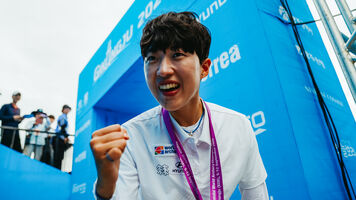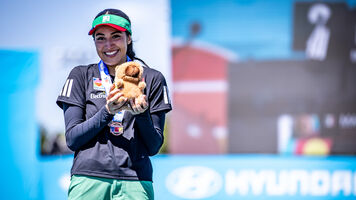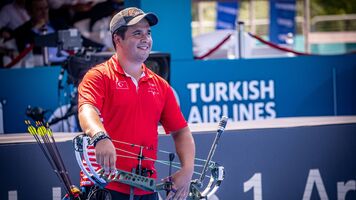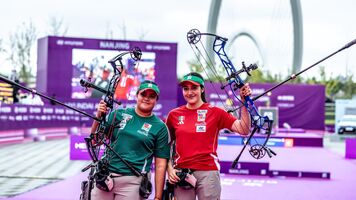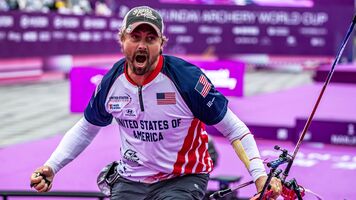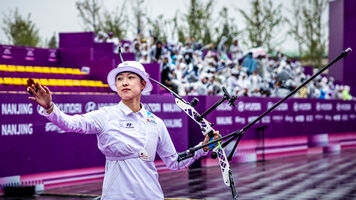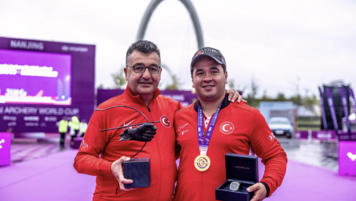Facts and figures: Guide to the 2025 Hyundai Archery World Cup
Updated on 3 April 2025 for the current season.
The Hyundai Archery World Cup is archery’s annual international tournament circuit, bringing together the world’s best archers to compete across a season of elite events around the globe.
Launched in 2006, the tour enters its 19th season in 2025 with four stages (compared to three in Olympic years), culminating in a season-ending apotheosis where only the best of the best are invited to compete.
Stage winners automatically qualify for the grand final, with remaining spots filled based on Hyundai Archery World Cup Ranking points.
Men’s and women’s Hyundai Archery World Cup Champions are crowned at the final event in two bowstyles – recurve, which is the Olympic discipline, and compound – while stages also host events for teams and mixed teams.
Finals are broadcast worldwide on archery+ and the circuit offers the largest prize purse of any international archery tournament, totalling more than 400,000 CHF, with each champion receiving 30,000 CHF in 2025.
This year, the primary rule change is the removal of an early elimination round for high-attendance stages, with only the top 64 qualifiers advancing to matchplay and no byes granted.
Calendar: 2025 Hyundai Archery World Cup
| Event | Dates | City | Country |
|---|---|---|---|
| Stage 1 | 8-13 April | Central Florida | |
| Stage 2 | 6-11 May | Shanghai | |
| Stage 3 | 3-8 June | Antalya | |
| Stage 4 | 8-13 July | Madrid | |
| Final | 18-19 October | Nanjing |
By the numbers
Thirty-two archers compete at each Hyundai Archery World Cup Final, with eight in each of the four competition categories: recurve men, recurve women, compound men and compound women.
One of these eight spots is reserved for an archer from the host nation (which is China in 2025), up to four are awarded to stage winners – though this number decreases if an archer wins multiple events – and the remaining places are allocated based on the Hyundai Archery World Cup Ranking after the final stage of the season.
This marks the 19th season of the Hyundai Archery World Cup, which has been held annually since 2006, except for 2020 when it was cancelled due to the COVID-19 pandemic.
Sara Lopez (Colombia) is the most successful archer in the history of the tour, having won a record ninth Hyundai Archery World Cup Champion trophy in 2025. The next closest are Brady Ellison (USA) and Kim Woojin (Korea), each with five titles.
Lopez also leads the individual stage wins leaderboard with 12 victories, followed by Ellison and Mike Schloesser (Netherlands), who both have 10.
Retired compound archer Braden Gellenthien (USA) holds the record for the most podium finishes across all events (including team and mixed team) with 67, ahead of Woojin with 56 and Brady with 54.

Competition format
On the Hyundai Archery World Cup, recurve archers compete over a distance of 70 metres and shoot at targets measuring 122 centimetres in diameter, while compound archers compete over a distance of 50 metres and shoot at targets measuring 80 centimetres in diameter.
Each stage of the circuit begins with a qualifying round of 72 arrows and the total result is used to seed athletes (and teams) for eliminations matches.
These play out in a head-to-head bracket, the winner of each match advancing and the loser being eliminated until just four archers remain. The final four in each category then compete for the stage victory in the televised arena. (Team finals are also broadcast.)
The Hyundai Archery World Cup Final is a matchplay event and there is no qualifying round.
Instead, the eight archers who qualify in each category are put into a random draw to decide the seedings and they shoot a televised head-to-head bracket, from quarterfinals to final, to decide who will be named Hyundai Archery World Cup Champion.
Session schedule at stages*
| Day | Morning session | Afternoon session |
|---|---|---|
| Tuesday (day 1) | Practice | Compound qualification |
| Wednesday (day 2) | Compound team eliminations | Recurve qualification |
| Thursday (day 3) | Recurve team eliminations | Compound eliminations |
| Friday (day 4) | Mixed team eliminations | Recurve eliminations |
| Saturday (day 5) | Compound team finals (televised) | Compound final fours (televised) |
| Sunday (day 6) | Recurve team finals (televised) | Recurve final fours (televised) |
*With the exception of Antalya.
Matchplay rules
Recurve matches are decided using the set system. Archers shoot sets of three arrows and the archer with the highest score in the set receives two set points; both are awarded one set point if the set is tied. The first to six set points wins the match.
(Recurve team matches work in almost the same way. Teams shoot six arrows per set and mixed teams shoot four arrows per set. The first team or mixed team to five set points wins the match.)
Compound matches are decided using cumulative scoring. Archers shoot 15 arrows, split into five ends of three, and the archer with the highest total points score wins the match.
(Compound team matches work in almost the same way except teams shoot 24 arrows, split into four ends of six, and mixed teams shoot 16 arrows, split into four ends of four.)
The most exciting moment in archery is a tiebreak or single-arrow shoot-off. This occurs when two recurve archers are tied on five set points after five sets or when two compound archers are tied on total score after 15 arrows. Each archer shoots one arrow and the archer whose arrow lands closest to the middle of the target wins the match.
Draw, aim, shoot
Despite the significant distances involved, archery is a sport of exceptionally small margins.
The accuracy of athletes on the Hyundai Archery World Cup circuit is mind-boggling. While an arrow might travel 70 metres downrange (for recurve, compound is 50 metres), flying in an arc that lifts it up to six metres above the ground, a millimetre on the target can make all the difference.
Much of archery is a mental game and the physical differences from each arrow to each arrow can be minuscule – although critical.
There are key visible indicators to watch out for. Rhythm, release and reaction tell the story of each shot. The time an archer takes to aim reveals the pressure they’re feeling, the moment the arrow leaves the bow shows if they’re in control and often, the look on an athlete’s face when the shot is in the air says just as much as the points it scores on the target.
Archery boils down to: Draw, aim and shoot. Sounds easy, doesn’t it? It’s not.
The international season begins in April with the first stage of the Hyundai Archery World Cup in Shanghai, China.





